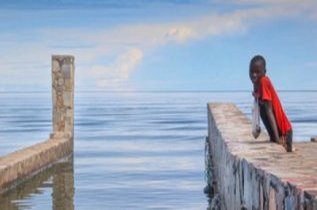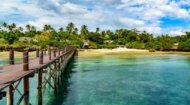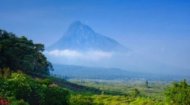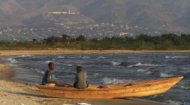But the lake's unique life extends far beyond cichlids. It is home to an impressive number of endemic invertebrates, including:
-
Freshwater crabs: Several species of specialized crabs, unique in their adaptations to the lake's environment.
- Molluscs: Over 100 species of endemic gastropods (snails) and numerous bivalves, many of which resemble marine forms due to convergent evolution in the stable, deep-water environment.
- Sponges: Specific to Lake Tanganyika, these freshwater sponges contribute to the lake's unique ecosystem.
- Jellyfish: Small, freshwater jellyfish (Limnocnida tanganyicae) are a peculiar sight, highlighting the lake's ancient and isolated nature.
The ecological dynamics of Lake Tanganyika are fundamentally shaped by its unique limnology. Below approximately 200 meters (650 feet), the water is permanently anoxic (devoid of oxygen) and contains high concentrations of hydrogen sulfide. This means that only the uppermost layer of the lake supports aerobic life. The deep, anoxic waters act as a "nutrient trap," limiting the vertical mixing that would bring nutrient-rich waters to the surface, thus influencing the lake's overall productivity and food web. This distinct stratification has played a crucial role in shaping the specialised adaptations of its endemic species.
 For millennia, human communities have thrived along the shores of Lake Tanganyika, their lives intricately woven with the rhythms of this colossal body of water. Millions across Tanzania, DRC, Burundi, and Zambia depend directly on the lake for their livelihoods, sustenance, and transportation. Fisheries are the economic backbone of the region. The lake supports a thriving fishing industry, with species like kapenta (Limnothrissa miodon and Stolothrissa tanganicae) and ndagala forming a crucial protein source for local populations and a significant component of regional trade. The fish are dried, smoked, or salted and transported far inland, providing income and food security to countless families. For millennia, human communities have thrived along the shores of Lake Tanganyika, their lives intricately woven with the rhythms of this colossal body of water. Millions across Tanzania, DRC, Burundi, and Zambia depend directly on the lake for their livelihoods, sustenance, and transportation. Fisheries are the economic backbone of the region. The lake supports a thriving fishing industry, with species like kapenta (Limnothrissa miodon and Stolothrissa tanganicae) and ndagala forming a crucial protein source for local populations and a significant component of regional trade. The fish are dried, smoked, or salted and transported far inland, providing income and food security to countless families.
Beyond fishing, Lake Tanganyika serves as a vital transportation artery. Ferries, cargo boats, and smaller canoes ply its waters, connecting remote communities, facilitating trade, and providing the primary means of communication and commerce in many areas where road infrastructure is limited. Towns like Kigoma in Tanzania, Kalemie in DRC, Bujumbura in Burundi, and Mpulungu in Zambia serve as key port cities, bustling with activity. The lake also holds cultural and historical significance. Its shores bear witness to ancient human settlements, and its waters have served as routes for explorers, traders, and missionaries for centuries. Dr. David Livingstone and Henry Morton Stanley famously met at Ujiji on the shores of Lake Tanganyika in 1871. Today, the lake is slowly emerging as a destination for tourism, with opportunities for sport fishing, diving to explore its cichlid diversity, and simply enjoying its breathtaking natural beauty.
Despite its immense size and ancient resilience, Lake Tanganyika faces a growing array of environmental challenges that threaten its delicate ecosystem and the livelihoods of those who depend on it. Climate change is arguably the most significant long-term threat. Rising air temperatures lead to warmer surface waters, which in turn enhance the thermal stratification of the lake. This amplifies the anoxic conditions in the deep waters, reducing the habitable zone for fish and other organisms. Warmer surface waters also lead to reduced mixing and nutrient upwelling, potentially decreasing primary productivity and impacting fish stocks. Changes in rainfall patterns can also affect water levels and nutrient runoff.
Pollution from burgeoning human populations along its shores is a pervasive problem. Untreated sewage, industrial waste, agricultural runoff (containing pesticides and fertilizers), and plastic debris are increasingly degrading water quality, leading to eutrophication, algal blooms, and the accumulation of toxic substances. Overfishing, driven by population growth and improved fishing technologies, is leading to a decline in fish stocks. Illegal fishing practices, such as the use of fine-meshed nets or destructive fishing methods, further exacerbate the problem, threatening the long-term sustainability of this vital resource. Deforestation in the lake's catchment area leads to increased soil erosion and sedimentation, which can affect fish spawning grounds and reduce water clarity. The introduction of invasive species, while currently limited, remains a potential threat to the lake's highly endemic ecosystem.
Recognizing the immense ecological, economic, and cultural value of Lake Tanganyika, concerted conservation efforts are underway, though much more is needed. Given its transboundary nature, international cooperation is paramount. Initiatives like the Lake Tanganyika Authority (LTA) and the Lake Victoria Basin Commission (LVBC) aim to promote sustainable management, coordinate research, and harmonize policies among the riparian states. Scientific research and monitoring are crucial to understanding the complex dynamics of the lake and the impacts of various threats, informing effective management strategies. Implementing sustainable fishing practices, promoting alternative livelihoods, and developing community-based conservation programs are essential for engaging local populations in protecting their vital resource. Establishing and effectively managing protected areas, both within the lake and in its catchment, also plays a critical role.
Lake Tanganyika stands as a living testament to the wonders of natural history and immense geological forces. Its unparalleled biodiversity, particularly its evolutionary showcase of cichlid fish, makes it a global ecological treasure. For millions of people, it is not merely a body of water but the very essence of their existence – a source of food, transport, and identity. However, this ancient jewel faces modern threats that demand immediate and sustained action. Preserving Lake Tanganyika is not just an environmental imperative; it is a moral responsibility to safeguard a unique natural heritage for future generations. By fostering international collaboration, investing in scientific understanding, and empowering local communities, we can ensure that Lake Tanganyika continues to thrive as Africa's ancient, deep, and indispensable heart.
|





 For millennia, human communities have thrived along the shores of Lake Tanganyika, their lives intricately woven with the rhythms of this colossal body of water. Millions across Tanzania, DRC, Burundi, and Zambia depend directly on the lake for their livelihoods, sustenance, and transportation. Fisheries are the economic backbone of the region. The lake supports a thriving fishing industry, with species like kapenta (Limnothrissa miodon and Stolothrissa tanganicae) and ndagala forming a crucial protein source for local populations and a significant component of regional trade. The fish are dried, smoked, or salted and transported far inland, providing income and food security to countless families.
For millennia, human communities have thrived along the shores of Lake Tanganyika, their lives intricately woven with the rhythms of this colossal body of water. Millions across Tanzania, DRC, Burundi, and Zambia depend directly on the lake for their livelihoods, sustenance, and transportation. Fisheries are the economic backbone of the region. The lake supports a thriving fishing industry, with species like kapenta (Limnothrissa miodon and Stolothrissa tanganicae) and ndagala forming a crucial protein source for local populations and a significant component of regional trade. The fish are dried, smoked, or salted and transported far inland, providing income and food security to countless families.


